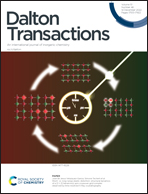A tandem process for in situ H2O2 formation coupled with benzyl alcohol oxidation using Pd–Au bimetallic catalysts†
Abstract
Alcohol oxidation is one of the most important industrial organic reactions. Traditionally, the best-suited catalysts are Pd, Pt and Au supported nanoparticles. The research community has recently started developing strategies for synthesizing carbon-supported Pd/Au bimetallic nanoparticles (NPs), leading to higher activities and selectivities. However, the metallic active species in these catalysts are usually generated using sodium borohydride (NaBH4), which is not synthetically easy to reproduce. In fact, minor modifications in pH, concentration and/or other parameters have a prominent effect on the nature of the promoted material. In this work, a robust process involving dihydrogen flow (H2) at 200 °C as a reducing agent for synthesizing Pd/Au supported bimetallic materials was considered an alternative to the common pathway. The physicochemical properties of the materials derived from different reducing reagents and of varying composition ranges were studied using HR-TEM, XRD, CO chemisorption, and XPS. Their stability and activity were also tested for benzyl alcohol oxidation to benzaldehyde under mild reaction conditions (60 °C, water as the solvent, and PO2 = 1.5 bar). Notably, a catalyst from the hydrogen reduction process with a metal composition of 0.8%Pd–0.2%Au/C consisting of bimetallic clusters (≈1.5 nm) proved to be the best material (C = 94%, S = 99%). Catalytic performances were strongly correlated with structural properties, such as nanoparticle size and distribution, which, in turn, were affected by the reduction step and the metal composition range. Finally, the influence of oxidants on benzyl alcohol oxidation has also been studied, along with the first approach for the tandem in situ formation of H2O2 coupled with alcohol oxidation.



 Please wait while we load your content...
Please wait while we load your content...